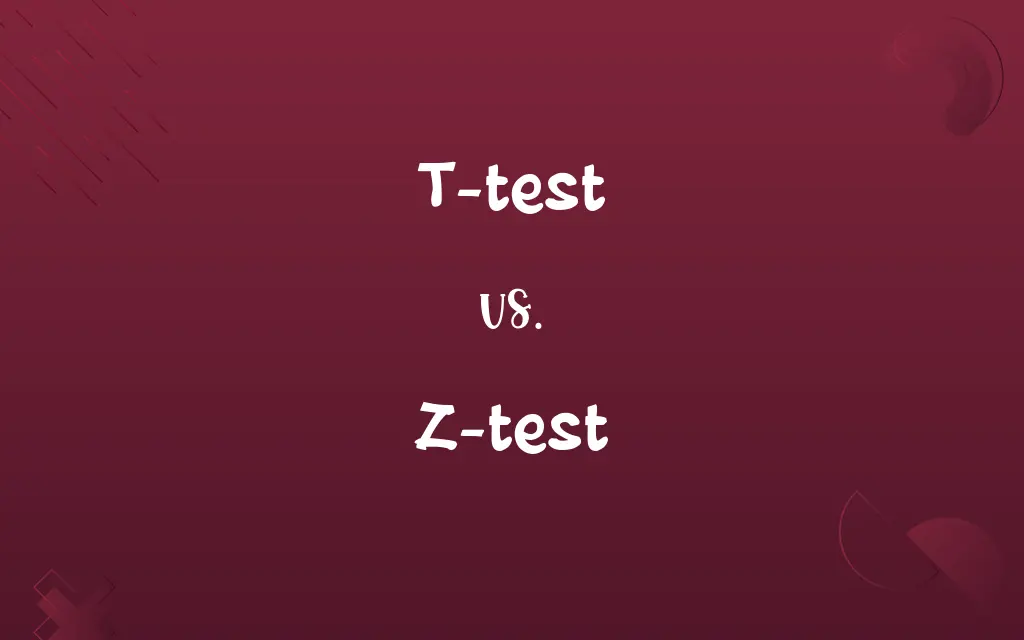T-test vs. Z-test: Know the Difference

By Shumaila Saeed || Published on January 23, 2024
A T-test is used to compare means with unknown variances or small sample sizes, while a Z-test is used for known variances and large sample sizes.

Key Differences
A T-test is a statistical method used when the sample size is small (typically less than 30) and the population variance is unknown. It's particularly useful in estimating the population mean from a small sample size. In contrast, a Z-test is suitable for larger sample sizes (usually over 30) and when the population variance is known, providing more precise results due to the law of large numbers.
Shumaila Saeed
Jan 23, 2024
The T-test is based on the t-distribution, a distribution that adjusts for small sample sizes. It's more adaptable to variations in smaller samples, making it more appropriate for studies with limited data. On the other hand, the Z-test utilizes the standard normal distribution (z-distribution) and is generally used when dealing with larger datasets where the central limit theorem holds true, ensuring the sample mean's distribution approximates normality.
Shumaila Saeed
Jan 23, 2024
In practice, the T-test is often employed in fields such as psychology, medicine, and other social sciences where small sample sizes are common. It allows researchers to make inferences about population parameters even with limited data. The Z-test, however, is commonly used in quality control processes in manufacturing, survey analysis, and other areas where large data sets are available and population parameters (like variance) are known.
Shumaila Saeed
Jan 23, 2024
When it comes to the calculation, the T-test takes into account the sample size through the degrees of freedom, which adjusts the critical values based on the sample size. This adjustment makes the t-distribution wider than the z-distribution, allowing for more uncertainty in smaller samples. The Z-test, with known variance, provides more precise confidence intervals and hypothesis testing results, assuming the sample size is sufficiently large to approximate the normal distribution.
Shumaila Saeed
Jan 23, 2024
The margin of error in a T-test is generally higher than in a Z-test, due to the variability inherent in smaller samples. This results in wider confidence intervals. In contrast, the Z-test, with its reliance on larger samples and known variances, tends to have a smaller margin of error and narrower confidence intervals, offering more precise estimates.
Shumaila Saeed
Jan 23, 2024
ADVERTISEMENT
Comparison Chart
Field of Use
Psychology, medicine, social sciences
Manufacturing, survey analysis
Shumaila Saeed
Jan 23, 2024
ADVERTISEMENT
Calculation
Adjusts for sample size variability
Based on large sample size normality
Shumaila Saeed
Jan 23, 2024
T-test and Z-test Definitions
T-test
It estimates population parameters from small, uncertain samples.
Researchers employed a T-test to analyze the survey results from a small focus group.
Shumaila Saeed
Jan 09, 2024
ADVERTISEMENT
Z-test
It's a hypothesis test in which the Z-statistic follows a normal distribution.
The Z-test revealed that the new drug's effects were statistically significant.
Shumaila Saeed
Jan 09, 2024
T-test
It's used when population variance is unknown and the sample is small.
The T-test assessed the impact of a new teaching method in a sample of 20 students.
Shumaila Saeed
Jan 09, 2024
Z-test
Z-test is often used to test hypotheses about population proportions.
They conducted a Z-test to determine if the proportion of voters favoring the policy differed significantly from 50%.
Shumaila Saeed
Jan 09, 2024
T-test
A T-test is a statistical test for comparing means in small samples.
A T-test was used to compare the effectiveness of two medications in a small clinical trial.
Shumaila Saeed
Jan 09, 2024
Z-test
Z-test is applied when the population variance is known and the sample size is large.
With a large sample size and known variance, a Z-test was the appropriate choice for their study.
Shumaila Saeed
Jan 09, 2024
T-test
T-test provides flexibility in hypothesis testing with limited data.
A T-test was conducted to see if a new small-scale marketing strategy was effective.
Shumaila Saeed
Jan 09, 2024
Z-test
This test compares the mean of a sample to a known population mean with a standard deviation.
A Z-test was conducted to compare the average height of the sample group to the national average.
Shumaila Saeed
Jan 09, 2024
T-test
A T-test adapts to sample size variations using the t-distribution.
A T-test determined if there was a significant difference in test scores between two small classes.
Shumaila Saeed
Jan 09, 2024
Z-test
A Z-test is a statistical test used to determine if there is a significant difference between sample and population means.
They used a Z-test to ascertain if the new teaching method significantly affected test scores.
Shumaila Saeed
Jan 09, 2024
Repeatedly Asked Queries
When should you use a T-test?
Use a T-test when comparing the means of two groups, especially with small sample sizes or unknown population variances.
Shumaila Saeed
Jan 23, 2024
What is a T-test?
A T-test is a statistical test used to compare the means of two groups.
Shumaila Saeed
Jan 23, 2024
What are the types of T-tests?
There are three main types: independent two-sample T-test, paired T-test, and one-sample T-test.
Shumaila Saeed
Jan 23, 2024
What does a T-test measure?
A T-test measures the difference between two means relative to the variation in the data.
Shumaila Saeed
Jan 23, 2024
What assumptions are made in a T-test?
The T-test assumes normally distributed data, independent samples, and, depending on the type, equal variances.
Shumaila Saeed
Jan 23, 2024
Can you use a T-test for paired data?
Yes, the paired T-test is specifically designed for dependent or paired samples.
Shumaila Saeed
Jan 23, 2024
Are T-tests and Z-tests parametric tests?
Yes, both are parametric tests, assuming data follows a certain distribution.
Shumaila Saeed
Jan 23, 2024
Can T-tests be used for large samples?
Yes, but they are most appropriate for smaller samples (usually less than 30).
Shumaila Saeed
Jan 23, 2024
How do T-tests and Z-tests differ?
T-tests are used for small samples with unknown population variance, while Z-tests are for large samples with known variance.
Shumaila Saeed
Jan 23, 2024
When is a Z-test appropriate?
A Z-test is appropriate for large sample sizes (usually over 30) and when the population variance is known.
Shumaila Saeed
Jan 23, 2024
Can Z-tests be used for small samples?
Generally, Z-tests are not suitable for small samples due to the assumption of known population variance.
Shumaila Saeed
Jan 23, 2024
Can Z-tests be used for proportions?
Yes, Z-tests are often used to test hypotheses about population proportions.
Shumaila Saeed
Jan 23, 2024
How do sample sizes affect the choice between T-test and Z-test?
Smaller samples typically require a T-test, while larger samples are more suited for a Z-test.
Shumaila Saeed
Jan 23, 2024
What is a Z-test?
A Z-test is a statistical method to determine if there is a significant difference between sample and population means.
Shumaila Saeed
Jan 23, 2024
What assumptions are made in a Z-test?
Z-tests assume a normal distribution, known population variance, and large sample size.
Shumaila Saeed
Jan 23, 2024
What is the key statistic in a T-test?
The T-statistic, calculated from the sample data, is key in a T-test.
Shumaila Saeed
Jan 23, 2024
What is the key statistic in a Z-test?
The Z-statistic, derived from sample data, is central in a Z-test.
Shumaila Saeed
Jan 23, 2024
Can T-tests be one-sided or two-sided?
Yes, T-tests can be structured as either one-tailed or two-tailed tests.
Shumaila Saeed
Jan 23, 2024
Is software required to perform T-tests or Z-tests?
While these tests can be done manually, statistical software makes them easier and more accurate.
Shumaila Saeed
Jan 23, 2024
Do T-tests and Z-tests require random sampling?
Yes, both tests assume that the samples are randomly selected.
Shumaila Saeed
Jan 23, 2024
Share this page
Link for your blog / website
HTML
Link to share via messenger
About Author
Written by
Shumaila SaeedShumaila Saeed, an expert content creator with 6 years of experience, specializes in distilling complex topics into easily digestible comparisons, shining a light on the nuances that both inform and educate readers with clarity and accuracy.








































































